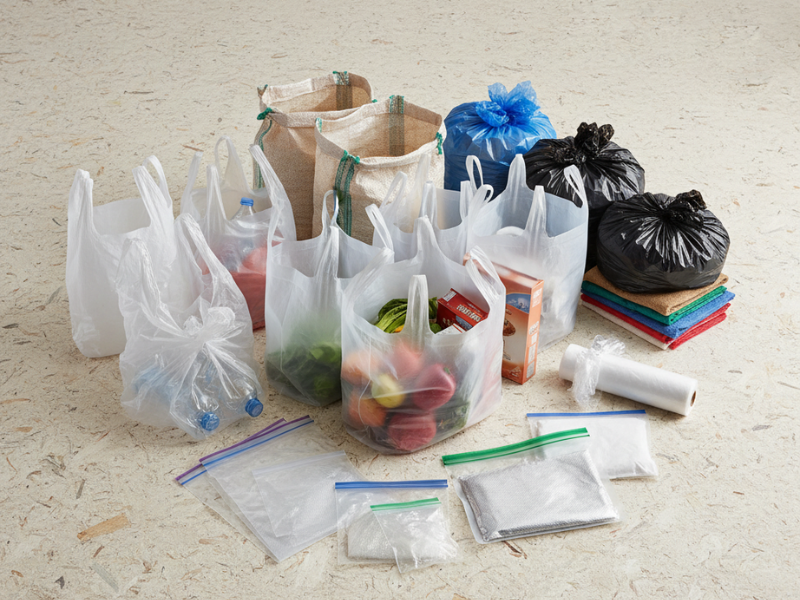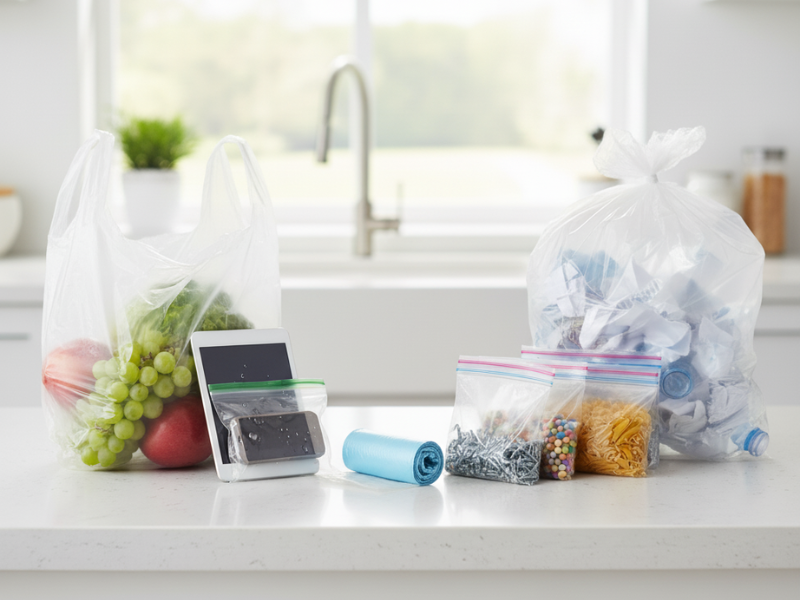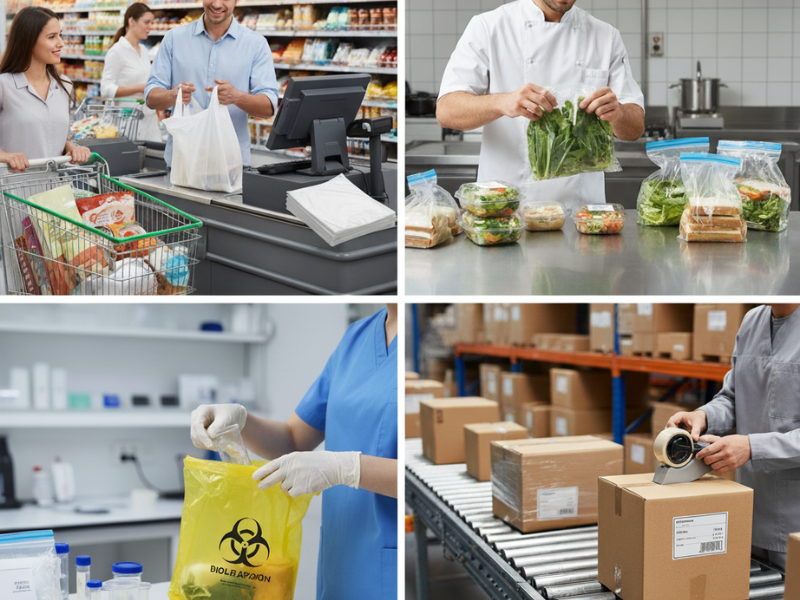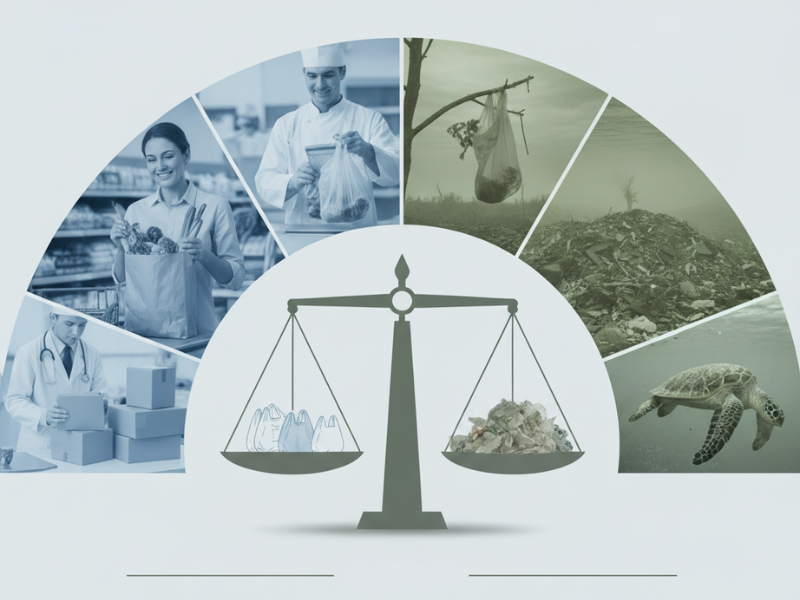.png)
When the topic of plastic bags is mentioned, most people immediately think about environmental impacts. Yet plastic bags also deliver practical benefits that often go unnoticed in both daily life and modern business operations. EcoPlastic provides an overview of these overlooked advantages to highlight why plastic bags continue to hold significance within today’s supply chains.
1. Overview of Plastic Bags
Plastic bags are manufactured primarily from polymers such as polyethylene or polypropylene. Over time, they have evolved into multiple categories, each designed for particular applications.
- HDPE (High-Density Polyethylene): Strong and durable, widely used in supermarkets and convenience stores.
- LDPE (Low-Density Polyethylene): Flexible and stretchable, suitable for packaging food items and lightweight products.
- PP (Polypropylene): Clear and visually appealing, commonly applied in packaging consumer goods.
- Biodegradable Plastic Bags: Engineered to degrade more quickly under specific conditions, considered a more eco-conscious option in some scenarios.
This classification provides a foundation for understanding the roles and advantages of plastic bags across industries.

Overview of Plastic Bags
2. Key Advantages of Plastic Bags
2.1 Lightweight and Space-Saving
Plastic bags are extremely light and occupy minimal storage space. Retailers can stock large volumes without requiring extensive storage, while consumers can easily carry multiple bags at once.
2.2 Cost-Effective Production
Compared with alternatives such as paper or cloth bags, plastic bags are far less expensive to produce. A low production cost explains their widespread use across retail chains, food services, and e-commerce packaging.
2.3 Durability and Moisture Resistance
Plastic bags withstand water exposure and resist tearing. This property ensures reliable protection of perishable goods, garments, or other items that must remain dry and intact.
2.4 Versatility in Branding and Customization
Printing technology allows plastic bags to carry brand logos, marketing messages, and colorful designs. This function transforms an everyday packaging item into a low-cost promotional tool.
2.5 Energy Efficiency in Transportation
Due to their lightweight nature, plastic bags reduce shipping loads. Lower transport weight contributes to reduced fuel consumption and fewer carbon emissions during distribution.

Key Advantages of Plastic Bags
2.6 Protection of Goods
Plastic bags act as a barrier against air, humidity, and contamination. In the food industry, this protection helps extend shelf life and maintain freshness for fruits, vegetables, meat, and baked goods.
2.7 Reusability for Everyday Purposes
Despite being considered single-use in many discussions, plastic bags are often reused at home. Common uses include lining trash bins, carrying groceries again, or storing items in refrigerators and freezers.
2.8 Recyclability
Modern recycling systems allow plastic bags to be processed into new products such as pipes, composite materials, or even new bags. While challenges remain, recycling technology continues to improve collection and conversion rates.
2.9 Safety and Convenience
Plastic bags pose fewer safety risks than glass or rigid containers, as they do not shatter. They also offer quick packaging solutions suitable for various industries, from retail to healthcare.
3. Practical Applications of Plastic Bags
3.1 Retail and Supermarkets
Plastic bags have become essential at checkout counters, enabling fast and efficient service for both staff and customers.
3.2 Food Industry
From fresh produce to ready-to-eat meals, plastic bags maintain hygiene standards and prevent cross-contamination.
3.3 Healthcare
In hospitals and laboratories, plastic bags are indispensable for handling medical waste, disposable instruments, and specimen storage.
3.4 Logistics and E-Commerce
With the growth of online shopping, plastic packaging ensures products are delivered securely while minimizing shipping costs.

Practical Applications of Plastic Bags
4. Balancing Advantages and Environmental Concerns
While plastic bags offer many advantages, environmental challenges remain. Several approaches help reduce negative impact:
- Promoting repeated use instead of single-use habits.
- Expanding collection and recycling infrastructure.
- Applying biodegradable alternatives in specific contexts.
- Raising awareness about responsible disposal practices.
By implementing these strategies, societies can maintain the benefits of plastic bags while addressing ecological concerns more effectively.

Balancing Advantages and Environmental Concerns
5. FAQ – Frequently Asked Questions
5.1 Are plastic bags always harmful to the environment?
The environmental impact depends on disposal practices. With responsible use and recycling, plastic bags can function with less harm.
5.2 What happens when plastic bags are discarded as litter?
Improper disposal causes plastic bags to remain in ecosystems for decades, threatening wildlife and polluting natural habitats.
5.6 Can plastic bags be considered sustainable?
When reused, recycled, and integrated with biodegradable options, plastic bags can be incorporated into a sustainable packaging approach.
Conclusion
Through this article, Eco has helped you understand the real advantages of plastic bags and how to use them wisely. Plastic bags remain a practical solution in modern life, combining low cost, durability, and convenience across multiple industries.














